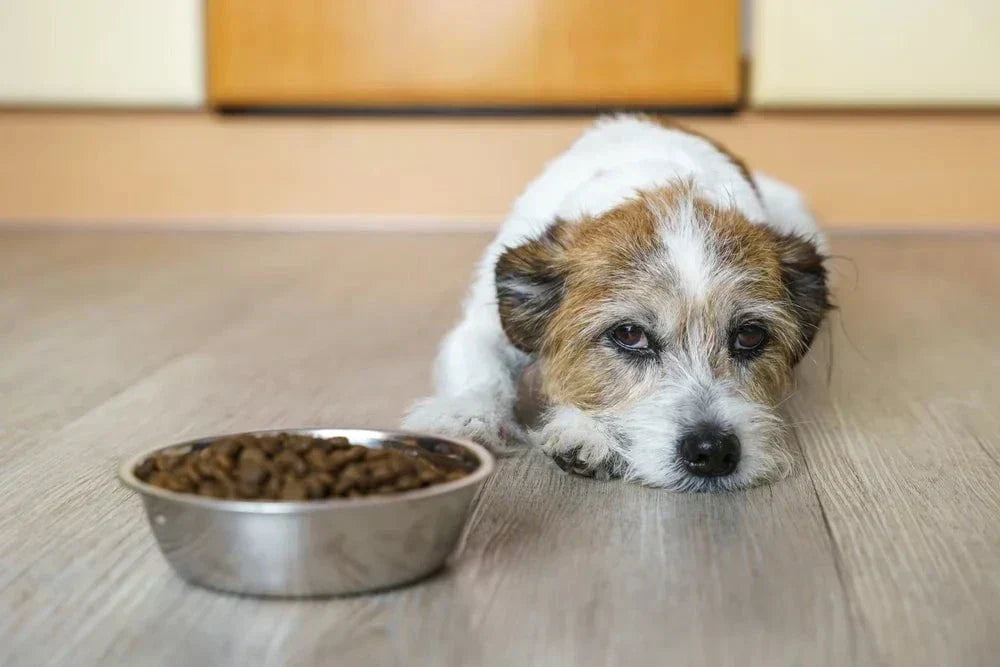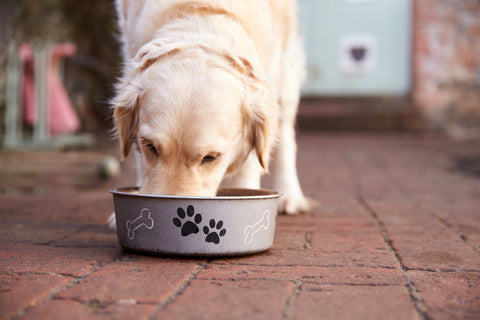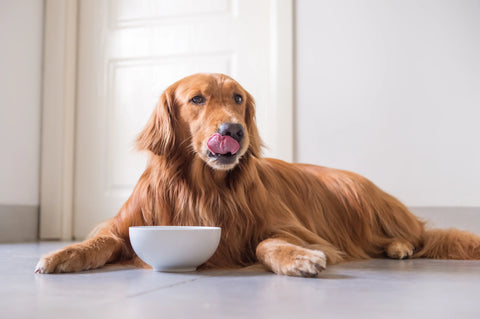

Gastroenteritis in dogs: What do I need to know?
Gastroenteritis in dogs might sound worrying, but it’s actually quite common. In this quick guide, we’ll walk you through the causes, symptoms, treatment options and recovery process – so you’ll know when to take it seriously, and why, with prompt care, there’s usually no need to panic.
What is gastroenteritis in dogs?
Let’s break down the word:
- gastro refers to the stomach,
- entero to the intestines, and
- -itis means inflammation
So, gastroenteritis quite literally means inflammation of the stomach and intestines.
It’s a label for a group of symptoms – not a diagnosis in itself. In fact, most cases of vomiting and diarrhoea in dogs fall under the umbrella of gastroenteritis. Find out about other common stomach problems in dogs.
If there’s any blood in your dog’s vomit or diarrhoea, it may be classed as haemorrhagic gastroenteritis. In more serious cases, your dog’s poop might even look like raspberry jam – and it definitely won’t smell pleasant.
Gastroenteritis in puppies
Puppies can develop gastroenteritis for many of the same reasons as adult dogs – but their risk profile is a little different.
- Incomplete vaccination or worming
- Stress from weaning, moving into a new home, or changes in diet
- They explore with their mouths – so they’re more likely to eat something they shouldn’t
One of the main concerns, even in uncomplicated gastroenteritis, is dehydration in dogs. This can happen quickly in puppies, and they often can’t rehydrate fast enough just by drinking – especially if they’re also being sick. A rarer complication is something called intussusception, where uncoordinated gut contractions cause part of the intestine to telescope into itself, cutting off blood flow.
That’s why even if an adult dog and a puppy have gastroenteritis caused by the same thing, the treatment approach can be very different. With puppies, it’s always best to err on the side of caution and get them checked sooner rather than later.
Symptoms of gastroenteritis in dogs
The signs of gastroenteritis can vary in severity, but here are the most common symptoms to look out for:
- Vomiting – This might happen once or several times and can include food, water, yellow bile, pink-tinged fluid or even material resembling coffee grounds (which may indicate digested blood).
-
Diarrhoea – Anything from a soft pile to porridge-like or completely liquid. It may be explosive and can include:
- Fresh streaks or drips of blood
- Blood mixed into the poop (which can resemble raspberry jam)
- Mucus or jelly around the poo
- Noisy tummy – Your dog's stomach is gurgling, bubbling, popping sounds or excessive gas
- Dehydration – Look for sticky gums or sunken eyes
- Abdominal pain – Your dog may be tense, reluctant to be touched or adopt a hunched posture
- Fever – Often accompanied by lethargy or warmth to the touch
- Lethargy or depression – Less energy and often sit on their own.
When to wait – and when to call the vet
In a fit, healthy adult dog who only vomits once and passes soft (but not liquid) diarrhoea with no blood, experienced owners may choose to monitor things carefully for up to 12 hours.
But if your dog shows multiple symptoms – especially blood, fever, lethargy or signs of pain – don’t wait. Get in touch with your vet straight away.
[pet-profile-digestive]
What causes gastroenteritis in dogs?
There are lots of possible causes. Some clear up quickly on their own, while others need urgent care:
- Infections – Bacterial or viral, for example, parvovirus.
- Worms and parasites
- Dietary indiscretion – Scavenging things that could loosely be described as ‘food’, including spoiled items and rubbish.
- Foreign bodies – For example, toys, bones, socks and string.
- Toxins – For example, plants, human food, medications and chemicals.
- Breed predisposition – Some small breeds are prone to haemorrhagic gastroenteritis.
- Other conditions – Liver, kidney, pancreatic disease, hormone imbalances or cancer.
- Drug reactions
- Mechanical issues – Twisting, telescoping or blockages requiring surgery.
How long does gastroenteritis last in dogs?
The active symptoms of gastroenteritis – vomiting and diarrhoea – can last for varying amounts of time. In many mild cases that are treated promptly, vomiting often settles within 24 hours, while diarrhoea can take a bit longer to clear as any irritants work their way through the digestive system.
More serious causes, along with puppies, small breeds, older dogs or those with existing health concerns, may take longer to stabilise and are more at risk of complications like dehydration.
Even when symptoms ease fairly quickly, your dog may still need a few more days to feel fully back to normal – we’ll cover that a bit further down.
Is gastroenteritis in dogs contagious?
Some – but not all – causes of gastroenteritis are contagious, either to other dogs or even to humans (these are called zoonotic diseases). Bacterial infections, viruses and certain parasites can all spread between animals – and in some cases, from dogs to people.
That’s why good hygiene really matters. If your vet says it’s safe to care for your dog at home:
- Keep your dog in a separate, easy-to-clean area – ideally somewhere with hard floors rather than carpet.
- Wash your hands thoroughly after handling them, their food, water bowls or any messes.
- Don’t let young children cuddle or nurse them while they’re recovering – no matter how well-meaning.
- Keep a bucket with sterilising fluid nearby for soaking bowls, bedding or toys – it helps stop germs spreading around the house via contaminated surfaces (called fomites).

Gastroenteritis treatment in dogs
Treatment for gastroenteritis focuses on three things: the underlying cause, the symptoms and the potential consequences – like dehydration or discomfort.
The first step is always a thorough veterinary check-up to assess hydration levels, signs of shock or pain, and your dog’s overall condition. Depending on what the vet finds, they may recommend further tests such as blood work, faecal analysis, X-rays or an ultrasound to help guide the right treatment plan.
Common treatment options include:
- Anti-sickness injections
- Binding pastes, neutralising agents and gut protectants
- Fluids – either electrolyte solutions at home or IV fluids at the clinic
- Antibiotics – but only if there’s clear evidence of a bacterial infection
- Worming medication – especially if parasites are suspected
- Surgery – in cases involving obstructions, foreign objects or twisted intestines
- A bland diet – highly digestible, low-fat food given in small portions
If your vet says your dog’s well enough to recover at home, they’ll usually recommend:
- Withholding food for 12-24 hours to let the gut rest (depending on your dog’s age and size)
- Reintroducing food gradually with a bland, low-fat diet, fed little and often – such as skinless, boneless boiled chicken or egg mixed with an equal amount of white rice
Hydration tips:
- Encourage your dog to drink a pet-safe electrolyte solution – but always make sure fresh water is available too
- Try to get them drinking little and often – some dogs wait until they’re really thirsty, then gulp, which can trigger more vomiting
Dog gastroenteritis recovery time
Recovery time depends on how severe the episode was – and whether there’s an underlying cause that still needs attention. The good news? The gut renews its lining quickly, and most dogs bounce back well with the right care.
Recovery might take longer if:
- Your dog has lost a lot of weight
- A long course of antibiotics is needed
- Surgery was involved
- Your dog has ongoing health concerns
It can take several weeks to fully restore a healthy gut microbiome. A good-quality diet, along with probiotic or prebiotic supplements, can help rebuild gut resilience.
Is gastroenteritis in dogs fatal?
In most cases, gastroenteritis isn’t life-threatening – especially when treated early. But severe or untreated cases can become serious, particularly for:
- Puppies or senior dogs
- Dogs with existing health concerns
- Cases involving toxins, parvovirus or surgical emergencies
- Dogs who don’t receive treatment soon enough
It’s usually not the gastroenteritis itself that poses the biggest risk, but the underlying cause. A prompt veterinary diagnosis gives your dog the best chance of a full recovery.
How to prevent gastroenteritis in dogs
While not every case can be prevented, there’s plenty you can do to help reduce your dog’s risk of gastroenteritis:
- Feed a high-quality, balanced diet
- Make dietary changes gradually over 5-7 days
- Be cautious with new treats, table scraps and raw or fatty foods
- If your dog tends to gulp down anything on walks, consider using a basket muzzle
- Keep vaccinations and worming up to date
- Puppy-proof your home to limit access to harmful substances or objects
Supporting gut health
For dogs prone to tummy troubles – or those with health conditions that affect digestion – there are a few extra ways you can help support a healthier gut in your dog:
- Try a digestive supplement such as a dog probiotic
- Choose easily digestible food with limited ingredients
- Ask your vet about sensitive or prescription diets tailored to your dog’s needs.



